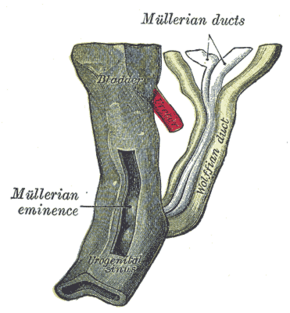Biology:Sinus tubercle
From HandWiki
Short description: Proliferation of endoderm induced by the paramesonephric ducts
| Sinus tubercle | |
|---|---|
 Urogenital sinus of female human embryo of eight and a half to nine weeks old. | |
| Anatomical terminology |
Sinus tubercle (also known as sinual tubercle[1] or Müllerian eminence) is the proliferation of endoderm induced by the paramesonephric ducts. It is located in the developing fetus between the orifices of the mesonephric ducts on the urogenital sinus.[1] The uterovaginal primoridium, which is a fusion of the caudal ends of paramesonephric ducts, contacts the dorsal wall of the urogenital sinus and, induces the formation of the sinus tubercle. This occurs in both sexes:
- In the female, the mesonephric duct loses all association with the gonad and, disappears. The sinus tubercle then gives rise to the sino-vaginal bulbs and, when it later becomes solid it is referred to as the vaginal plate.[1] It likewise gives rise to the hymen, which eventually breaks down in most cases.
- In the males, the sinus tubercle gives rise to the seminal colliculus.
References
- Moore Persaud, Medical embryology 2003
- ↑ 1.0 1.1 1.2 Ruchelli, Eduardo D.; Ruchelli, Eduardo D.; Huff, Dale S.; Huff, Dale S. (2011), Ernst, Linda M.; Ruchelli, Eduardo D.; Huff, Dale S., eds., "Vagina" (in en), Color Atlas of Fetal and Neonatal Histology (New York, NY: Springer): pp. 195–198, doi:10.1007/978-1-4614-0019-6_17, ISBN 978-1-4614-0019-6, https://doi.org/10.1007/978-1-4614-0019-6_17, retrieved 2021-05-27
 |

